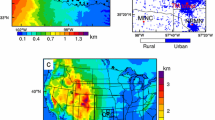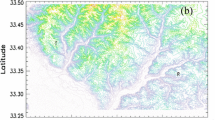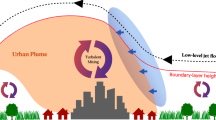Abstract
Turbulent and intermittent characteristics of the nocturnal boundary layer play an important role in determining the transport, diffusion, and storage of momentum, heat, and atmospheric pollutants. Here we use micrometeorological observations and numerical simulations to analyze two coherent turbulent structures—a density current and a low-level jet (LLJ)—that enhance mixing and intermittent turbulence in the nocturnal boundary layer. We analyze in detail their impact on the distribution of simulated pollutant concentrations. The Weather Research and Forecast (WRF) model is coupled with the Community Multiscale Air Quality photochemical model to simulate the dispersion of pollutants for the density-current and LLJ cases. The terms of the pollutant-concentration budget are then analyzed to quantify the contribution of different atmospheric processes on the net \(\hbox {NO}_2\) and \(\hbox {O}_3\) concentrations. The results show that the WRF model reproduces successfully the essential characteristics observed in the density-current and LLJ cases. The density-current simulation shows turbulent-mixing enhancement in the frontal zone of the density current, leading to significant vertical pollutant diffusion. Results also indicate that the LLJ is able to transport pollutants from the residual layer to the surface layer due to vertical diffusion. In both cases, the main mechanism responsible for pollutant transport is the horizontal advection.









Similar content being viewed by others
References
Acevedo OC, Moraes OL, Degrazia GA, Medeiros LE (2006) Intermittency and the exchange of scalars in the nocturnal surface layer. Boundary-Layer Meteorol 119(1):41–55
Adachi A, Clark W, Hartten L, Gage K, Kobayashi T (2004) An observational study of a shallow gravity current triggered by katabatic flow. Ann Geophys Copernic GmbH 22:3937–3950
Balsley BB, Svensson G, Tjernström M (2008) On the scale-dependence of the gradient richardson number in the residual layer. Boundary-Layer Meteorol 127(1):57–72
Banks RF, Baldasano JM (2016) Impact of WRF model PBL schemes on air quality simulations over Catalonia, Spain. Sci Total Environ 572:98–113
Banks RF, Tiana-Alsina J, Baldasano JM, Rocadenbosch F, Papayannis A, Solomos S, Tzanis CG (2016) Sensitivity of boundary-layer variables to PBL schemes in the WRF model based on surface meteorological observations, lidar, and radiosondes during the HygrA-CD campaign. Atmos Res 176:185–201
Banta RM (2008) Stable-boundary-layer regimes from the perspective of the low-level jet. Acta Geophys 56(1):58–87
Bhave P, Nolte C, Pleim J, Schwede D, Roselle S (2005) Recent developments in the CMAQ modal aerosol module. In: Proceedings of the models-3 users workshop
Blumen W, Grossman R, Piper M (1999) Analysis of heat budget, dissipation and frontogenesis in a shallow density current. Boundary-Layer Meteorol 91(2):281–306
Borge R, Santiago JL, de la Paz D, Martín F, Domingo J, Valdés C, Sánchez B, Rivas E, Rozas MT, Lázaro S et al (2018) Application of a short term air quality action plan in Madrid (Spain) under a high-pollution episode-part II: assessment from multi-scale modelling. Sci Total Environ 635:1574–1584
Bougeault P, Lacarrère P (1989) Parameterization of orography-induced turbulence in a mesobeta-scale model. Mon Weather Rev 117(8):1872–1890
Bravo M, Mira T, Soler M, Cuxart J (2008) Intercomparison and evaluation of MM5 and Meso-NH mesoscale models in the stable boundary layer. Boundary-Layer Meteorol 128(1):77–101
Bretherton CS, Park S (2009) A new moist turbulence parameterization in the Community Atmosphere Model. J Clim 22(12):3422–3448
Byun DW, Ching J et al (1999) Science algorithms of the EPA models-3 community multiscale air quality (CMAQ) modeling system. US Environmental Protection Agency, Office of Research and Development, Washington, DC
Chemel C, Staquet C, Largeron Y (2009) Generation of internal gravity waves by a katabatic wind in an idealized alpine valley. Meteorol Atmos Phys 103(1–4):187–194
Chen F, Dudhia J (2001) Coupling an advanced land surface-hydrology model with the penn state-ncar MM5 modeling system. Part I: model implementation and sensitivity. Mon Weather Rev 129(4):569–585
Conangla L, Cuxart J (2006) On the turbulence in the upper part of the low-level jet: an experimental and numerical study. Boundary-Layer Meteorol 118(2):379–400
Coulter RL, Kallistratova MA (2004) Two decades of progress in sodar techniques: a review of 11 isars proceedings. Meteorol Atmos Phys 85(1):3–19
Cuxart J (2008) Nocturnal basin low-level jets: an integrated study. Acta Geophys 56(1):100–113
Cuxart J, Jiménez M (2007) Mixing processes in a nocturnal low-level jet: an LES study. J Atmos Sci 64(5):1666–1679
Cuxart J, Yagüe C, Morales G, Terradellas E, Orbe J, Calvo J, Fernández A, Soler M, Infante C, Buenestado P et al (2000) Stable atmospheric boundary-layer experiment in Spain (SABLES 98): a report. Boundary-Layer Meteorol 96(3):337–370
Dudhia J (1989) Numerical study of convection observed during the winter monsoon experiment using a mesoscale two-dimensional model. J Atmos Sci 46(20):3077–3107
Ferreres E, Soler M, Terradellas E (2013) Analysis of turbulent exchange and coherent structures in the stable atmospheric boundary layer based on tower observations. Dyn Atmos Oceans 64:62–78
Floors R, Vincent CL, Gryning SE, Peña A, Batchvarova E (2013) The wind profile in the coastal boundary layer: wind lidar measurements and numerical modelling. Boundary-Layer Meteorol 147(3):469–491
Freedman FR, Bornstein RD (1998) Study of the spacial and temporal structure of turbulence in the nocturnal residual layer. In: Gryning SE, Chaumerliac N (eds) Air pollution modeling and its application XII. NATO \(\bullet \) Challenges of modern society, vol 22. Springer, Boston
Garratt JR (1994) The atmospheric boundary layer. Cambridge atmospheric and space science series. Cambridge University Press, Cambridge
Gonçalves M, Jiménez-Guerrero P, Baldasano JM (2009) Contribution of atmospheric processes affecting the dynamics of air pollution in south-western europe during a typical summertime photochemical episode. Atmos Chem Phys 9(3):849–864
Grell GA, Dévényi D (2002) A generalized approach to parameterizing convection combining ensemble and data assimilation techniques. Geophys Res Lett 29(14):38–1
Hong SY, Noh Y, Dudhia J (2006) A new vertical diffusion package with an explicit treatment of entrainment processes. Mon Weather Rev 134(9):2318–2341
Hong C, Zhang Q, Zhang Y, Tang Y, Tong D, He K (2017) Multi-year downscaling application of two-way coupled WRF v3. 4 and CMAQ v5. 0.2 over east Asia for regional climate and air quality modeling: model evaluation and aerosol direct effects. Geosci Model Dev 10(6):2447–2470
Hu XM, Nielsen-Gammon JW, Zhang F (2010) Evaluation of three planetary boundary layer schemes in the WRF model. J Appl Meteorol Climatol 49(9):1831–1844
Hu XM, Doughty DC, Sanchez KJ, Joseph E, Fuentes JD (2012) Ozone variability in the atmospheric boundary layer in Maryland and its implications for vertical transport model. Atmos Environ 46:354–364
Hu XM, Klein PM, Xue M, Zhang F, Doughty DC, Forkel R, Joseph E, Fuentes JD (2013) Impact of the vertical mixing induced by low-level jets on boundary layer ozone concentration. Atmos Environ 70:123–130
Hu J, Chen J, Ying Q, Zhang H (2016) One-year simulation of ozone and particulate matter in China using WRF/CMAQ modeling system. Atmos Chem Phys 16(16):10,333–10,350
Hu J, Li X, Huang L, Ying Q, Zhang Q, Zhao B, Wang S, Zhang H (2017) Ensemble prediction of air quality using the WRF/CMAQ model system for health effect studies in China. Atmos Chem Phys 17(21):13,103–13,118
Jang JCC, Jeffries HE, Byun D, Pleim JE (1995a) Sensitivity of ozone to model grid resolution. Application of high-resolution regional acid deposition model. Atmos Environ 29(21):3085–3100
Jang JCC, Jeffries HE, Tonnesen S (1995b) Sensitivity of ozone to model grid resolution. Detailed process analysis for ozone chemistry. Atmos Environ 29(21):3101–3114
Janjić ZI (2002) Nonsingular implementation of the Mellor–Yamada level 2.5 scheme in the NCEP meso model. NCEP office note, vol 437, p 61
Janjic ZI (1990) The step-mountain coordinate: physical package. Mon Weather Rev 118(7):1429–1443
Li L, Chen C, Huang C, Huang H, Zhang G, Wang Y, Wang H, Lou S, Qiao L, Zhou M et al (2012) Process analysis of regional ozone formation over the Yangtze river delta, China using the community multi-scale air quality modeling system. Atmos Chem Phys 12(22):10,971–10,987
Mahrt L (1982) Momentum balance of gravity flows. J Atmos Sci 39(12):2701–2711
Mahrt L (1999) Stratified atmospheric boundary layers. Boundary-Layer Meteorol 90(3):375–396
Mahrt L (2014) Stably stratified atmospheric boundary layers. Annu Rev Fluid Mech 46:23–45
Martínez D, Cuxart J (2009) Assessment of the hydraulic slope flow approach using a mesoscale model. Acta Geophys 57(4):882–903
Misenis C, Zhang Y (2010) An examination of sensitivity of WRF/Chem predictions to physical parameterizations, horizontal grid spacing, and nesting options. Atmos Res 97(3):315–334
Mlawer EJ, Taubman SJ, Brown PD, Iacono MJ, Clough SA (1997) Radiative transfer for inhomogeneous atmospheres: RRTM, a validated correlated-k model for the longwave. J Geophys Res 102(14):16663–16682
Nakanishi M, Niino H (2006) An improved Mellor–Yamada level-3 model: its numerical stability and application to a regional prediction of advection fog. Boundary-Layer Meteorol 119(2):397–407
Pleim JE (2007) A combined local and nonlocal closure model for the atmospheric boundary layer. Part I: model description and testing. J Appl Meteorol Climatol 46(9):1383–1395
Pleim JE, Chang JS (1992) A non-local closure model for vertical mixing in the convective boundary layer. Atmos Environ A Gen Top 26(6):965–981
Prabha TV, Hoogenboom G, Smirnova TG (2011) Role of land surface parameterizations on modeling cold-pooling events and low-level jets. Atmos Res 99(1):147–161
Prtenjak MT, Jeričević A, Klaić ZB, Alebić-Juretić A, Bulić IH (2013) Atmospheric dynamics and elevated ozone concentrations in the northern adriatic. Meteorol Appl 20(4):482–496
Pugh TA, Ryder J, MacKenzie AR, Moller SJ, Lee JD, Helfter C, Nemitz E, Lowe D, Hewitt CN (2010) Modelling chemistry in the nocturnal boundary layer above tropical rainforest and a generalised effective nocturnal ozone deposition velocity for sub-ppbv NOx conditions. J Atmos Chem 65(2–3):89–110
Querol X, Gangoiti G, Mantilla E, Alastuey A, Minguillón MC, Amato F, Reche C, Viana M, Moreno T, Karanasiou A, Rivas I, Pérez N, Ripoll A, Brines M, Ealo M, Pandolfi M, Lee HK, Eun HR, Park YH, Escudero M, Beddows D, Harrison RM, Bertrand A, Marchand N, Lyasota A, Codina B, Olid M, Udina M, Jiménez-Esteve B, Soler MR, Alonso L, Millán M, Ahn KH (2017) Phenomenology of high-ozone episodes in ne Spain. Atmos Chem Phys 17(4):2817–2838
Renfrew IA (2004) The dynamics of idealized katabatic flow over a moderate slope and ice shelf. Q J R Meteorol Soc 130(598):1023–1045
Román-Cascón C, Yagüe C, Mahrt L, Sastre M, Steeneveld G, Pardyjak E, van de Boer A, Hartogensis O (2015) Interactions among drainage flows, gravity waves and turbulence: a BLLAST case study. Atmos Chem Phys 15(8):12,821–12,865
Rotach MW, Vogt R, Bernhofer C, Batchvarova E, Christen A, Clappier A, Feddersen B, Gryning SE, Martucci G, Mayer H, Mitev V, Oke TR, Parlow E, Richner H, Roth M, Roulet YA, Ruffieux D, Salmond JA, Schatzmann M, Voogt JA (2005) BUBBLE—an urban boundary-layer meteorology project. Theor Appl Climatol 81(3):231–261
Salmond J, McKendry I (2002) Secondary ozone maxima in a very stable nocturnal boundary layer: observations from the Lower Fraser Valley, BC. Atmos Environ 36(38):5771–5782
San José R, Casanova J, Viloria RE, Casanova J (1985) Evaluation of the turbulent parameters of the unstable surface boundary layer outside businger’s range. Atmos Environ (1967) 19(10):1555–1561
Shankar U, Bhave P, Vukovich J, Roselle S (2005) Implementation and initial applications of sea salt aerosol emissions and chemistry algorithms in the CMAQ v4.5-aero4 module. In: 4th annual CMAS models-3 users conference, Chapel Hill, NC, pp 26–28
Shin HH, Hong SY (2011) Intercomparison of planetary boundary-layer parametrizations in the WRF model for a single day from CASES-99. Boundary-Layer Meteorol 139(2):261–281
Siebert H, Wendisch M, Conrath T, Teichmann U, Heintzenberg J (2003) A new tethered balloon-borne payload for fine-scale observations in the cloudy boundary layer. Boundary-Layer Meteorol 106(3):461–482
Simpson JE (1999) Gravity currents: in the environment and the laboratory. Cambridge University Press, Cambridge
Skamarock WC, Klemp J, Dudhia J, Gill D, Barker D, Wang W, Powers J (2008) A description of the advanced research WRF version 3. NCAR technical notes-475+ str. National Center for Atmospheric Research (NCAR)
Smith EN, Gibbs JA, Fedorovich E, Klein PM (2018) WRF model study of the great plains low-level jet: effects of grid spacing and boundary layer parameterization. J Appl Meteorol Climatol 57(10):2375–2397. https://doi.org/10.1175/JAMC-D-17-0361.1
Soler M, Infante C, Buenestado P, Mahrt L (2002) Observations of nocturnal drainage flow in a shallow gully. Boundary-Layer Meteorol 105(2):253–273
Soler M, Udina M, Ferreres E (2014) Observational and numerical simulation study of a sequence of eight atmospheric density currents in northern Spain. Boundary-Layer Meteorol 153(2):195–216
Storm B, Dudhia J, Basu S, Swift A, Giammanco I (2009) Evaluation of the weather research and forecasting model on forecasting low-level jets: implications for wind energy. Wind Energy 12(1):81–90
Stull RB (1988) An introduction to boundary layer meteorology. Kluwer Academic Publishers, Dordrecht
Sukoriansky S, Galperin B, Perov V et al (2006) A quasi-normal scale elimination model of turbulence and its application to stably stratified flows. Nonlinear Process Geophys 13(1):9–22
Sun J, Burns SP, Lenschow DH, Banta R, Newsom R, Coulter R, Frasier S, Ince T, Nappo C, Cuxart J et al (2002) Intermittent turbulence associated with a density current passage in the stable boundary layer. Boundary-Layer Meteorol 105(2):199–219
Sun J, Lenschow DH, Burns SP, Banta RM, Newsom RK, Coulter R, Frasier S, Ince T, Nappo C, Balsley BB et al (2004) Atmospheric disturbances that generate intermittent turbulence in nocturnal boundary layers. Boundary-Layer Meteorol 110(2):255–279
Terradellas E, Morales G, Cuxart J, Yagüe C (2001) Wavelet methods: application to the study of the stable atmospheric boundary layer under non-stationary conditions. Dyn Atmos Oceans 34(2):225–244
Terradellas E, Soler M, Ferreres E, Bravo M (2005) Analysis of oscillations in the stable atmospheric boundary layer using wavelet methods. Boundary-Layer Meteorol 114(3):489–518
Thompson G, Rasmussen RM, Manning K (2004) Explicit forecasts of winter precipitation using an improved bulk microphysics scheme. Part I: description and sensitivity analysis. Mon Weather Rev 132(2):519–542
Tjernström M, Balsley B, Svensson G, Nappo C (2008) Observations of turbulence in the residual layer. In: 18th symposium on boundary layers and turbulence
Udina M, Soler MR, Arasa R (2012) Effects of nocturnal thermal circulation and boundary layer structure on pollutant dispersion in complex terrain areas: a case study. Int J Environ Pollut 48(1):47–59
Udina M, Soler MR, Viana S, Yagüe C (2013) Model simulation of gravity waves triggered by a density current. Q J R Meteorol Soc 139(672):701–714
Viana S, Yagüe C, Maqueda G, Morales G (2007) Study of the surface pressure fluctuations generated by waves and turbulence in the nocturnal boundary layer during SABLES2006 field campaign. Física de la Tierra 19:55–71
Viana S, Yagüe C, Maqueda G (2009) Propagation and effects of a mesoscale gravity wave over a weakly-stratified nocturnal boundary layer during the SABLES2006 field campaign. Boundary-Layer Meteorol 133(2):165–188
Viana S, Terradellas E, Yagüe C (2010) Analysis of gravity waves generated at the top of a drainage flow. J Atmos Sci 67(12):3949–3966
Wang X, Zhang Y, Hu Y, Zhou W, Lu K, Zhong L, Zeng L, Shao M, Hu M, Russell A (2010) Process analysis and sensitivity study of regional ozone formation over the Pearl River Delta, China, during the PRIDE-PRD2004 campaign using the Community Multiscale Air Quality modeling system. Atmos Chem Phys 10(9):4423–4437
Wang N, Guo H, Jiang F, Ling Z, Wang T (2015) Simulation of ozone formation at different elevations in mountainous area of Hong Kong using WRF-CMAQ model. Sci Total Environ 505:939–951
Yagüe C, Viana S, Maqueda G, Lazcano MF, Morales G, Rees JM (2007) A study on the nocturnal atmospheric boundary layer: SABLES2006. Física de la Tierra 19:37–53
Yarwood G, Rao S, Yocke M, Whitten G (2005) Updates to the carbon bond chemical mechanism: CB05. Final report to the US EPA, RT-0400675 8
Yus-Díez J, Udina M, Soler MR, Lothon M, Nilsson E, Bech J, Sun J (2019) Nocturnal boundary layer turbulence regimes analysis during the bllast campaign. Atmos Chem Phys 19(14):9495–9514
Zhang H, Chen G, Hu J, Chen SH, Wiedinmyer C, Kleeman M, Ying Q (2014) Evaluation of a seven-year air quality simulation using the Weather Research and Forecasting (WRF)/Community Multiscale Air Quality (CMAQ) models in the eastern United States. Sci Total Environ 473:275–285
Acknowledgements
The work was supported by the Spanish Government through the MINECO Projects CGL2012-37416-C04-04, CGL2015-65627-C3-2-R and CGL2016-81828-REDT.
Author information
Authors and Affiliations
Corresponding author
Additional information
Publisher's Note
Springer Nature remains neutral with regard to jurisdictional claims in published maps and institutional affiliations.
Appendix Control Case: Meteorological Analysis
Appendix Control Case: Meteorological Analysis
The meteorological analysis for the control cases corresponding to the night of 17–18 July 2003 is given in Fig. 10. In the control case 1, the concentrations are explored at 1900 UTC (see the purple vertical line in Fig. 10). In the control case 2, the selected comparison time is at 2300 UTC (see brown vertical line in Fig. 10).
Time series from 1800 UTC on 17 July 2003 to 0600 UTC on 18 July 2003 for a air temperature, b wind speed, c wind direction, d specific humidity measured at different levels of the CIBA tower (all averaged over 5-min periods). Vertical lines indicate the selected times: the control case 1 (CC1, purple line), sunset (at around 1952 UTC, black dashed line), and the control case 2 (CC2, brown line)
Rights and permissions
About this article
Cite this article
Udina, M., Soler, M.R., Olid, M. et al. Pollutant vertical mixing in the nocturnal boundary layer enhanced by density currents and low-level jets: two representative case studies. Boundary-Layer Meteorol 174, 203–230 (2020). https://doi.org/10.1007/s10546-019-00483-y
Received:
Accepted:
Published:
Issue Date:
DOI: https://doi.org/10.1007/s10546-019-00483-y





